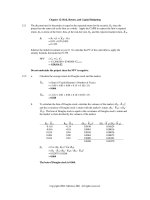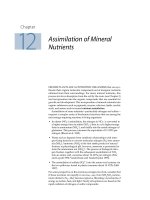Chapter 12 Mass - Storage Systems
Bạn đang xem bản rút gọn của tài liệu. Xem và tải ngay bản đầy đủ của tài liệu tại đây (485.28 KB, 49 trang )
Chapter 12: Mass-Storage Systems
Chapter 12: Mass-Storage Systems
12.2
Silberschatz, Galvin and Gagne ©2005
Operating System Concepts – 7
th
Edition, Jan 1, 2005
Chapter 12: Mass-Storage Systems
Chapter 12: Mass-Storage Systems
■
Overview of Mass Storage Structure
■
Disk Structure
■
Disk Attachment
■
Disk Scheduling
■
Disk Management
■
Swap-Space Management
■
RAID Structure
■
Disk Attachment
■
Stable-Storage Implementation
■
Tertiary Storage Devices
■
Operating System Issues
■
Performance Issues
12.3
Silberschatz, Galvin and Gagne ©2005
Operating System Concepts – 7
th
Edition, Jan 1, 2005
Objectives
Objectives
■
Describe the physical structure of secondary and tertiary storage devices
and the resulting effects on the uses of the devices
■
Explain the performance characteristics of mass-storage devices
■
Discuss operating-system services provided for mass storage, including
RAID and HSM
12.4
Silberschatz, Galvin and Gagne ©2005
Operating System Concepts – 7
th
Edition, Jan 1, 2005
Overview of Mass Storage Structure
Overview of Mass Storage Structure
■
Magnetic disks provide bulk of secondary storage of modern computers
●
Drives rotate at 60 to 200 times per second
●
Transfer rate is rate at which data flow between drive and computer
●
Positioning time (random-access time) is time to move disk arm to
desired cylinder (seek time) and time for desired sector to rotate under
the disk head (rotational latency)
●
Head crash results from disk head making contact with the disk
surface
That’s bad
■
Disks can be removable
■
Drive attached to computer via I/O bus
●
Busses vary, including EIDE, ATA, SATA, USB, Fibre Channel, SCSI
●
Host controller in computer uses bus to talk to disk controller built
into drive or storage array
12.5
Silberschatz, Galvin and Gagne ©2005
Operating System Concepts – 7
th
Edition, Jan 1, 2005
Moving-head Disk Machanism
Moving-head Disk Machanism
12.6
Silberschatz, Galvin and Gagne ©2005
Operating System Concepts – 7
th
Edition, Jan 1, 2005
Overview of Mass Storage Structure (Cont.)
Overview of Mass Storage Structure (Cont.)
■
Magnetic tape
●
Was early secondary-storage medium
●
Relatively permanent and holds large quantities of data
●
Access time slow
●
Random access ~1000 times slower than disk
●
Mainly used for backup, storage of infrequently-used data,
transfer medium between systems
●
Kept in spool and wound or rewound past read-write head
●
Once data under head, transfer rates comparable to disk
●
20-200GB typical storage
●
Common technologies are 4mm, 8mm, 19mm, LTO-2 and
SDLT
12.7
Silberschatz, Galvin and Gagne ©2005
Operating System Concepts – 7
th
Edition, Jan 1, 2005
Disk Structure
Disk Structure
■
Disk drives are addressed as large 1-dimensional arrays of logical blocks,
where the logical block is the smallest unit of transfer.
■
The 1-dimensional array of logical blocks is mapped into the sectors of the
disk sequentially.
●
Sector 0 is the first sector of the first track on the outermost
cylinder.
●
Mapping proceeds in order through that track, then the rest of
the tracks in that cylinder, and then through the rest of the
cylinders from outermost to innermost.
12.8
Silberschatz, Galvin and Gagne ©2005
Operating System Concepts – 7
th
Edition, Jan 1, 2005
Disk Attachment
Disk Attachment
■
Host-attached storage accessed through I/O ports talking to I/O busses
■
SCSI itself is a bus, up to 16 devices on one cable, SCSI initiator requests
operation and SCSI targets perform tasks
●
Each target can have up to 8 logical units (disks attached to
device controller
■
FC is high-speed serial architecture
●
Can be switched fabric with 24-bit address space – the basis of
storage area networks (SANs) in which many hosts attach to
many storage units
●
Can be arbitrated loop (FC-AL) of 126 devices
12.9
Silberschatz, Galvin and Gagne ©2005
Operating System Concepts – 7
th
Edition, Jan 1, 2005
Network-Attached Storage
Network-Attached Storage
■
Network-attached storage (NAS) is storage made available over a network
rather than over a local connection (such as a bus)
■
NFS and CIFS are common protocols
■
Implemented via remote procedure calls (RPCs) between host and storage
■
New iSCSI protocol uses IP network to carry the SCSI protocol
12.10
Silberschatz, Galvin and Gagne ©2005
Operating System Concepts – 7
th
Edition, Jan 1, 2005
Storage Area Network
Storage Area Network
■
Common in large storage environments (and becoming more common)
■
Multiple hosts attached to multiple storage arrays - flexible
12.11
Silberschatz, Galvin and Gagne ©2005
Operating System Concepts – 7
th
Edition, Jan 1, 2005
Disk Scheduling
Disk Scheduling
■
The operating system is responsible for using hardware efficiently — for the
disk drives, this means having a fast access time and disk bandwidth.
■
Access time has two major components
●
Seek time is the time for the disk are to move the heads to the
cylinder containing the desired sector.
●
Rotational latency is the additional time waiting for the disk to
rotate the desired sector to the disk head.
■
Minimize seek time
■
Seek time ≈ seek distance
■
Disk bandwidth is the total number of bytes transferred, divided by the total
time between the first request for service and the completion of the last
transfer.
12.12
Silberschatz, Galvin and Gagne ©2005
Operating System Concepts – 7
th
Edition, Jan 1, 2005
Disk Scheduling (Cont.)
Disk Scheduling (Cont.)
■
Several algorithms exist to schedule the servicing of disk I/O requests.
■
We illustrate them with a request queue (0-199).
98, 183, 37, 122, 14, 124, 65, 67
Head pointer 53
12.13
Silberschatz, Galvin and Gagne ©2005
Operating System Concepts – 7
th
Edition, Jan 1, 2005
FCFS
FCFS
Illustration shows total head movement of 640 cylinders.
12.14
Silberschatz, Galvin and Gagne ©2005
Operating System Concepts – 7
th
Edition, Jan 1, 2005
SSTF
SSTF
■
Selects the request with the minimum seek time from the current head
position.
■
SSTF scheduling is a form of SJF scheduling; may cause starvation of
some requests.
■
Illustration shows total head movement of 236 cylinders.
12.15
Silberschatz, Galvin and Gagne ©2005
Operating System Concepts – 7
th
Edition, Jan 1, 2005
SSTF (Cont.)
SSTF (Cont.)
12.16
Silberschatz, Galvin and Gagne ©2005
Operating System Concepts – 7
th
Edition, Jan 1, 2005
SCAN
SCAN
■
The disk arm starts at one end of the disk, and moves toward the other end,
servicing requests until it gets to the other end of the disk, where the head
movement is reversed and servicing continues.
■
Sometimes called the elevator algorithm.
■
Illustration shows total head movement of 208 cylinders.
12.17
Silberschatz, Galvin and Gagne ©2005
Operating System Concepts – 7
th
Edition, Jan 1, 2005
SCAN (Cont.)
SCAN (Cont.)
12.18
Silberschatz, Galvin and Gagne ©2005
Operating System Concepts – 7
th
Edition, Jan 1, 2005
C-SCAN
C-SCAN
■
Provides a more uniform wait time than SCAN.
■
The head moves from one end of the disk to the other. servicing requests
as it goes. When it reaches the other end, however, it immediately returns
to the beginning of the disk, without servicing any requests on the return
trip.
■
Treats the cylinders as a circular list that wraps around from the last
cylinder to the first one.
12.19
Silberschatz, Galvin and Gagne ©2005
Operating System Concepts – 7
th
Edition, Jan 1, 2005
C-SCAN (Cont.)
C-SCAN (Cont.)
12.20
Silberschatz, Galvin and Gagne ©2005
Operating System Concepts – 7
th
Edition, Jan 1, 2005
C-LOOK
C-LOOK
■
Version of C-SCAN
■
Arm only goes as far as the last request in each direction, then reverses
direction immediately, without first going all the way to the end of the disk.
12.21
Silberschatz, Galvin and Gagne ©2005
Operating System Concepts – 7
th
Edition, Jan 1, 2005
C-LOOK (Cont.)
C-LOOK (Cont.)
12.22
Silberschatz, Galvin and Gagne ©2005
Operating System Concepts – 7
th
Edition, Jan 1, 2005
Selecting a Disk-Scheduling Algorithm
Selecting a Disk-Scheduling Algorithm
■
SSTF is common and has a natural appeal
■
SCAN and C-SCAN perform better for systems that place a heavy load on
the disk.
■
Performance depends on the number and types of requests.
■
Requests for disk service can be influenced by the file-allocation method.
■
The disk-scheduling algorithm should be written as a separate module of
the operating system, allowing it to be replaced with a different algorithm if
necessary.
■
Either SSTF or LOOK is a reasonable choice for the default algorithm.
12.23
Silberschatz, Galvin and Gagne ©2005
Operating System Concepts – 7
th
Edition, Jan 1, 2005
Disk Management
Disk Management
■
Low-level formatting, or physical formatting — Dividing a disk into sectors that the
disk controller can read and write.
■
To use a disk to hold files, the operating system still needs to record its own
data structures on the disk.
●
Partition the disk into one or more groups of cylinders.
●
Logical formatting or “making a file system”.
■
Boot block initializes system.
●
The bootstrap is stored in ROM.
●
Bootstrap loader program.
■
Methods such as sector sparing used to handle bad blocks.
12.24
Silberschatz, Galvin and Gagne ©2005
Operating System Concepts – 7
th
Edition, Jan 1, 2005
Booting from a Disk in Windows 2000
Booting from a Disk in Windows 2000
12.25
Silberschatz, Galvin and Gagne ©2005
Operating System Concepts – 7
th
Edition, Jan 1, 2005
Swap-Space Management
Swap-Space Management
■
Swap-space — Virtual memory uses disk space as an extension of main
memory.
■
Swap-space can be carved out of the normal file system,or, more
commonly, it can be in a separate disk partition.
■
Swap-space management
●
4.3BSD allocates swap space when process starts; holds text
segment (the program) and data segment.
●
Kernel uses swap maps to track swap-space use.
●
Solaris 2 allocates swap space only when a page is forced out
of physical memory, not when the virtual memory page is first
created.









